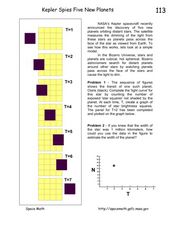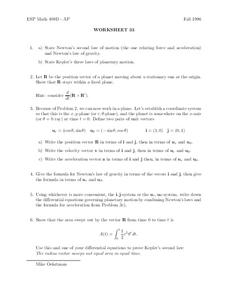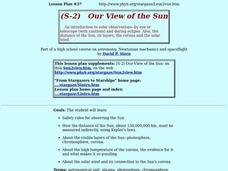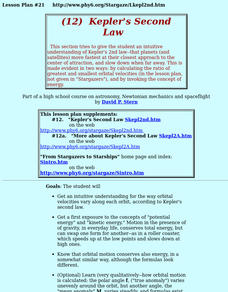Curated OER
Planet Paths: Studying Planetary Orbital Paths
Students define and identify planetary orbit, ellipse, parabola, and hyperbola, and simulate Kepler's Second Law. They explore interactive websites demonstrating orbital motion and complete modeling activities.
Curated OER
The Solar System
In this solar system worksheet, students will name the two models of the solar system and compare their differences. Students will state the hypothesis behind the formation of the sun and planets. Students will compare and contrast the...
Urbana School District
Gravitation
Introduction your class to famous astronomers with a presentation that also covers Newton's Laws of Gravitation, Kepler's Laws of Planetary Motion, both uniform and nonuniform gravitational fields, and how to calculate the gravitational...
BW Walch
Kelper's Second Law: How Do Planets Move?
Kepler's second law of planetary motion, specifically, the law of equal areas, is demonstrated by your high schoolers. On the provided graph paper, they mark out the designated path of Earth at two different times of the year and then...
Curated OER
Kepler Spies Five New Planets
In this discovering new planets instructional activity, students read about how the Kepler spacecraft detects new planets by observing the dimming of light emitted by stars as the planets pass in front of them. Students solve 2 problems...
Curated OER
Review of Gravitation
In this gravitation worksheet, students complete 50 multiple choice questions on universal gravitation topics and Kepler's laws.
Curated OER
Lesson Plan on Kepler's Laws of Planetary Motion
Students construct a solar system model. In this space science activity, students calculate the eccentricity of a planet's orbit. They calculate the period of a planet's revolution using Kepler's formula.
PBS
Analyzing Light Curves of Transiting Exoplanets
Scientists detected exoplanets by measuring how the brightness of stars changed over time. Young astronomers interpret and analyze the same data that led to exoplanet discoveries. They learn to apply light curve graphs and connect the...
Curated OER
Motions and Their Effects
With a simple blackboard-style appearance, these slides list facts about the reason for the seasons, solstices, and equinoxes. It also touches on Kepler's first law of planetary motion. There are no pictures or graphics to help explain...
Curated OER
Universal Gravitation and Kepler's Laws
Students develop problem-solving strategies dealing with Kepler's laws of planetary motion. they examine the law of universal gravitation and continue with problem-solving strategies. Students complete a take-home quiz.
Mr. E. Science
Our Solar System
The presentation starts with the scientists who made discoveries about our solar system: Ptolemy, Copernicus, Galileo, Brahe, Kepler, and Newton. It also covers the planets, inner, outer, and Pluto, satellites, and an in-depth discussion...
Curated OER
Worksheet 33
In this math worksheet, students state Newton's second law of motion and his law of gravity. Then they state Kepler's three laws of planetary motion.
Curated OER
Our View of the Sun
High schoolers are introduced to safety rules for observing the Sun, how the distance of the Sun is measured using Kepler's Laws and identify the visible layers of the Sun. They discuss solar eclipses and view images of eclipses using...
Curated OER
People of the Scientific Revolution
In this Scientific Revolution worksheet, learners read a brief overview of the contributions of Copernicus, Bacon, Kepler, Galileo, Newton, and Harvey.
Curated OER
Kepler's Third Law
Students use Kepler's third law to derive the velocity in a circular orbit of any radius, and identify the Earth escape velocity.
Curated OER
Kepler's Second Law
Students gain an understanding of Kepler's 2nd law--that planets (and satellites) move fastest at their closest approach to the center of attraction, and slow down when far away. They explore the concepts of "potential energy" and...
Curated OER
Kepler's Second Law
Pupils explore orbital velocities and how they vary along each orbit, according to Kepler's Second Law.
Curated OER
Black Holes...V
In this black hole worksheet, students read about the black hole in the center of the Milky Way Galaxy called Sagittarius A and observe a Chandra image of the area where the black hole exists. Students solve two problems which include...
Curated OER
Was Kepler Correct?
Students investigate the elliptical orbit around the Sun. They use the information gathered to measure the distance to the Sun from the closest orbital point and the farthest orbital point.
Curated OER
The Seasons
Discover the change of the seasons by modeling the Earth-Sun system. Learners model the orbit of the Earth around the sun and explore how and why the patterns of winter and summer occur.
TED-Ed
Tycho Brahe, the Scandalous Astronomer
Who says scientists are boring geeks? Certainly not the narrator of a short video who dishes up the scandals associated with Tycho Brahe, a Danish scientist and alchemist (now that's two labels you don't often see together) who used...
Curated OER
How Does a Satellite Stay in Orbit?
Students explore placing a satellite into orbit, then about forces needed to keep an object in orbit. They examine how satellites orbit in elliptical paths and about properties of ellipses. They learn Kepler's 3rd Law of Planetary Motion
Curated OER
Astronomer Research
Learners discover the contributions of early astronomers and scientists. In this research skills lesson, students research electronic and print sources about Galileo Galilei, Aristarchus, Hipparchus, Claudius Ptolemy, Nicholas...
Curated OER
Cosmic Wheels
Students build a scale model of the Solar System and determine the time other planets take to travel around the Sun in comparison to the time of the Earth's revolution. The velocity of the planets are also determined in this lesson.
Other popular searches
- Kepler's Laws
- Copernicus and Kepler
- Kepler's 3rd Law
- Kepler's Second Law
- Kepler Laws
- Kepler and Newton
- Johannes Kepler
- Keplers Laws
- Johann Kepler
- Kepler Copernicus Brahe
- Who Is Johannes Kepler
- Astronomy Kepler

























